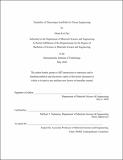Tunability of Electrospun Scaffolds for Tissue Engineering
Author(s)
Chyr, Gloria Un
DownloadThesis PDF (10.21Mb)
Advisor
Tarkanian, Michael J.
Terms of use
Metadata
Show full item recordAbstract
Electrospinning is a cheap and quick method of creating non-woven scaffolds for tissue regeneration and growth with the proper fiber diameter for cell adhesion. However, electrospun scaffolds lack large pores between fibers and result in a densely packed mesh in which cells can adhere only to the surface of the material. Control of scaffold fiber size and porosity is critical to ensure scaffolds have a fiber diameter appropriate for cell adhesion and a high-enough porosity to allow for cell migration through the material. This thesis aims to demonstrate the tunability and control of electrospun gelatin scaffolds to make them viable for use in tissue regeneration by altering grounded collector geometry and thus the electric field that nanofiber deposition follows. Previous electrospinning experiments show that processing parameters such as flow rate and voltage can affect fiber diameter and porosity, but are still insufficient in achieving dimensions viable for cell migration. Scaffold porosity is substantially more affected by the grounded collector geometry. By modifying collector geometry, pore size can be controlled without affecting fiber morphology and the deposition of gelatin nanofibers can be aligned or patterned to mimic natural tissue scaffolds. Introduction of a non-conductive, woven mesh in between the collector and source may allow further control of deposition patterns and thus scaffold construction. The path of electrospun fibers and the deposition patterns can be predicted by modeling the electric field.
Date issued
2020-05Department
Massachusetts Institute of Technology. Department of Materials Science and EngineeringPublisher
Massachusetts Institute of Technology